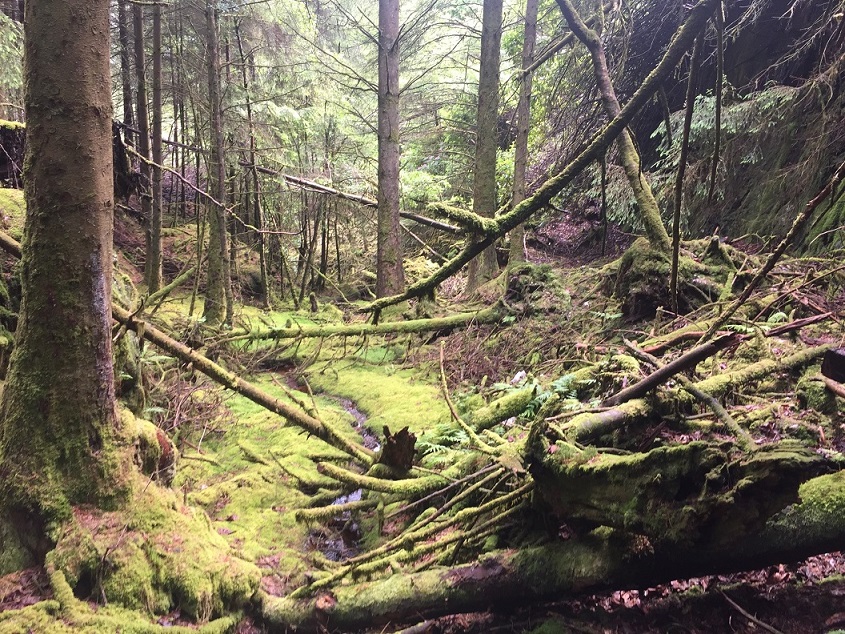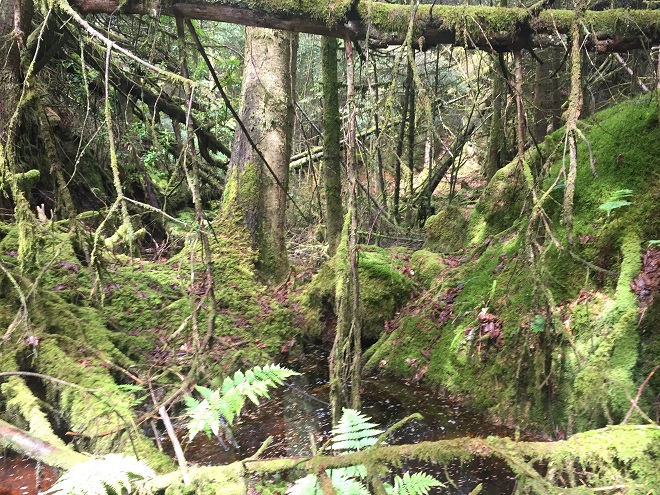By Nick Halls, resident of Ardentinny
This is the fifth in a series of articles about forestry in the National Park near where I live (see here)
The impact of windthrow

The value of the trees relative to the difficulty of extraction and the dangers posed by windblown trees makes harvesting from areas like this problematic. In what seems to an amazing piece of ‘double talk’ these areas are to be retained as ‘amenity’ woodland.
During preceding forestry cycles, clear linear gaps were left between blocks of woodland. They are referred to as ‘rides’. Techniques of felling and extraction have become more mechanized so these no longer seem to be necessary, so current replanting is denser and without any equivalent means of access.
During previous cycles, the forest rides were an important means of informal access, to the open hillside above.
Managing woodland open space for wildlife – according to Forestry.gov.uk
“What is a ride?
For the purpose of this document a ride is a linear open space within a wood derived from the need for access. Rides may have a hard surfaced track making up part of the width or more commonly are unsurfaced. The ride is usually made up of several zones. Most commonly ride consist of a central grass zone with a mixed herbaceous and shrub zone on one side or both sides.
The benefit of managed rides and open spaces
Sensitive management of open habitats introduces greater habitat diversity.
This encourages a larger range of species, adding diversity and additional interest for all types of recreation and sporting activities. Many species make use of the edge habitats for feeding due to higher herb layer productivity and larger invertebrate populations. A greater number of species inhabit the first 10metres of any woodland edge or ride edge than inhabit the remainder of the woodland’
Rides commonly became invaded by rhododendrons, fallen branches and wind blow, but it was possible to find a way through or around obstructions.

Obstructed water course, in a deep gully, where Rhododendron will reinvade. The debris has accumulated over decades, and demonstrates how little is done to develop the amenity value of the forest estate. Areas like this are not really suitable for modern mechanized clear fell and extraction methods.

I have experience of impenetrable natural woodland, from trying to access open hillside in Canada, Brazil, Japan and Patagonia. This sort of scene seems natural, but it is within 300 m from a public road, and five minutes from my home. In the midst of a State managed forestry plantation, in a National Park, in an area designated as amenity woodland.
“[A woodland managed primarily for amenity rather than for timber, often with public access for outdoor pursuits such as walking, mountain biking and orienteering, or alternatively managed for game.]”
It could be a very scenic, all age and abilities walk, that would economically enhance the visitor experience. Investment in such projects, during the 1980’s, gave employment, if only temporary and seasonal, and restored access to Pucks Glen, now one of the visitor attractions of Cowal.


Created in the 19th Century, completely blocked by accumulating wind blow in the mid 20th Century, cleared and restored, by young local unemployed supervised by foresters during Y.O.P. schemes of the 1980’s

Impenetrable nature of the forest floor, replicated throughout the woodland close to habitation. Nobody, except the fit and determined, are likely to enter the forest, but anybody not used, or unable, to walk off tarmac roads is unlikely to try. Neighbors seldom venture into the forest, if at all, they are too fearful of getting lost or slipping and injuring themselves.
The underfoot conditions and obstructions distorts visitor feed-back, by eliciting from visitors requests for tracks to enable them to enter the woodland. I suspect this does not mean artificial, over engineered circular tracks, with deep boggy side drains and overgrown banks, but ‘brashed’ [side branches removed to above head height] woodland and clear forest floors in the immediate vicinity of parking places and scenic areas. This would allow people to go for a wander through the woods.
Clearing the forest floor and making it more accessible would probably be cheaper, and keep people more permanently employed, than creating circular tracks, which are difficult to get off, and are then not maintained.
Acidification of aquifers.
It was established in Scandinavia some time ago that acidification of the aquifers draining into lakes and rivers, arising from planting conifers close to the banks of streams, eventually resulted in the decline of fish stocks. The acid flushes resulting from heavy rain washing through foliage and forest floor litter, causes fish eggs to become toughened resulting in failure to hatch.
This has been recognized, but not acted on except at the headwaters of some tributories to major streams and rivers draining into waters popular with anglers. Little has been done locally, so angling seems to be less and less popular as there are so few fish. Migratory fish like salmon and sea trout have disappeared from the River Finart [other factors may have contributed to this such as netting the migratory fish as they swim up the coast].
A small experiment in restoration

An attempt to clear historic wind blow, to improve the quality of water contributing to a garden pond, which is so acid nothing seems to live, and toad and frog spawn never hatches. The effort has apparently improved the situation, as this year for the first time in thirty years, mallards visited the pond and found something to eat! Note improved bio diversity along cleared stream edge.

Clearing the stream of debris and obstructions permitting the flow speed to increase, deepening the stream bed, lowering the water table and dried out the surrounding area, which is no longer an acid sphagnum bog. This improved the water quality of the pond, and improved bio diversity of the banks of the stream. It also restored access to the woodland.
The experiment convinced me that the manner in which forestry operations are carried out fundamentally damages the micro environment and degrades the full potential bio diversity. It is not necessary to watch a program about loss of habitat in some equatorial forest, it is happening in the artificial wet desert on our doorstep.
Post script
Current forestry practice has abandoned any activity that might encourage informal access within the woodland, between cycles of planting, thinning and clear fell. Access to the actual woodland, and possibilities of finding a way through it to the hillside above, has deteriorated.
Woodland in the immediate vicinity of habitation, or surrounding visitor attractions and facilities, described as ‘amenity’ woodland is virtually inaccessible and uninviting. Little if any attention is paid to the potential for informal active outdoor recreation.

In many localities, the bio diversity is artificially restricted, and access possibilities of any description deteriorating, and in no way compensated for by walking along industrial forestry road infrastructure, from which it is difficult to escape.
The dense forestry is treated as a scenic back drop for visitors, rather than an opportunity to encourage recreational activity!

Has there been any test of Scottish National Park authority/Forestry Commission attitude to voluntary clearing of access to “amenity” areas? Do they welcome/support this, or are they an obstruction? If the former, then perhaps, together (ahtority and public/voluntary groups), this issue might be partly addressed…